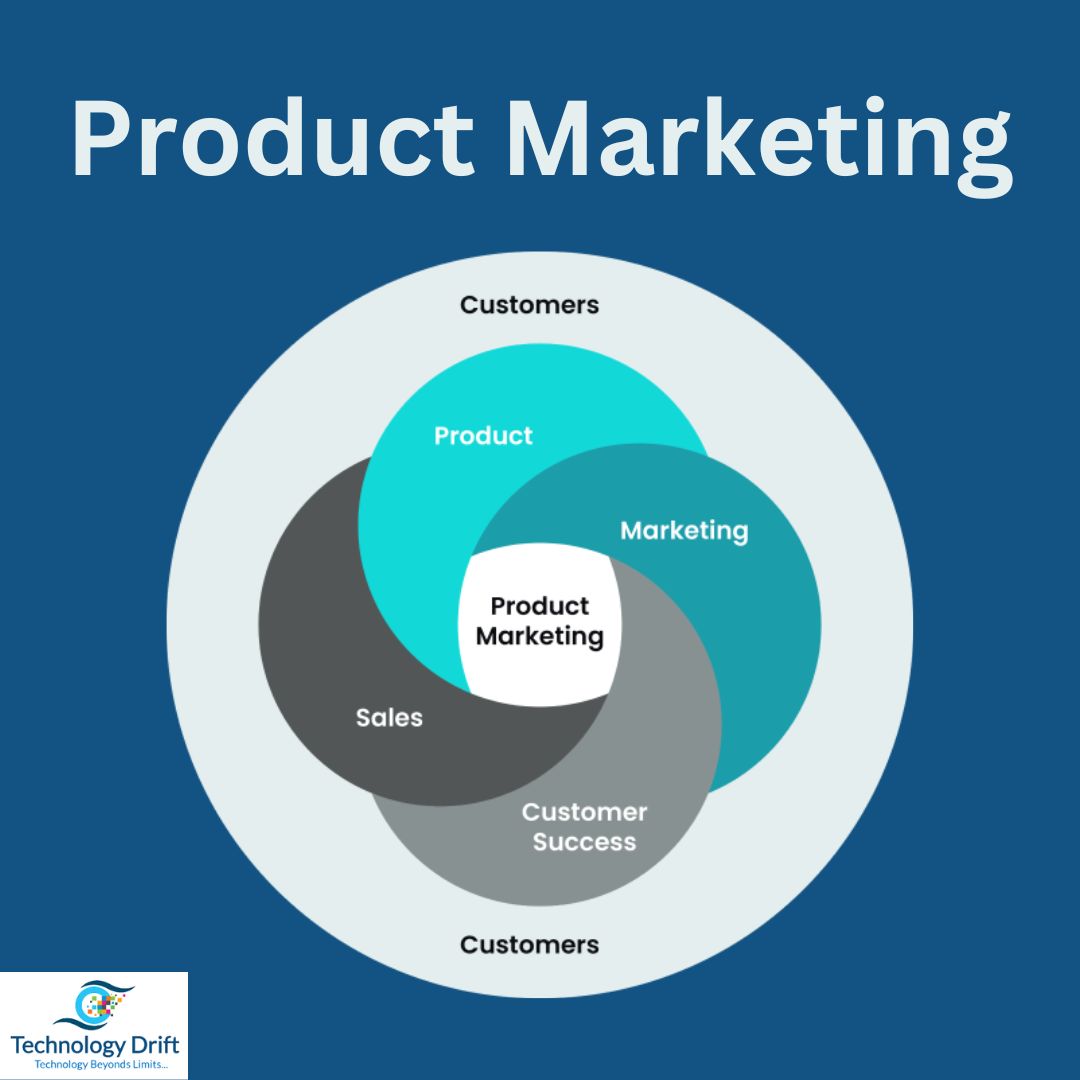Product marketing is a crucial aspect of a company’s overall marketing strategy. It involves the promotion and positioning of a specific product or product line in order to drive sales and generate revenue. The ultimate goal of product marketing is to increase brand awareness, generate demand, and build customer loyalty.
So it is important to understand everything about Product marketing to ensure the company’s success. So let us drive deeper and understand it from the beginning to end of this marketing strategy. To make this a simple and easy to learn we have divided this whole strategy into chapters so that it will be easy for you to learn and acquire it into your own product so that you can ensure that it will reach its full potential and drive revenue growth.
Chapter 1: Overview of product marketing
Definition of product marketing:
Product marketing refers to the activities and tactics used to promote a specific product or product line. It involves understanding the target market, positioning the product in the market, creating a unique value proposition, and developing a marketing mix (product, price, promotion, and place) to drive sales and generate revenue.
The role of product marketing in the overall marketing mix:
Product marketing is a crucial component of the overall marketing mix and plays a critical role in the success of a product. It helps companies to understand the needs and wants of their target market, position their product in the market, and create a strong brand identity. The marketing mix developed by product marketers also helps to guide the efforts of other departments such as sales, distribution, and customer service.
The differences between product marketing and other forms of marketing:
Product marketing is different from other forms of marketing such as brand marketing, consumer marketing, and B2B marketing. While all forms of marketing aim to promote a company’s products or services, product marketing is specifically focused on promoting a specific product or product line. In contrast, brand marketing focuses on promoting the overall brand and establishing brand recognition and loyalty, consumer marketing targets end-consumers, and B2B marketing targets other businesses.
Chapter 2: Conducting Market Research and Analysis
Understanding your target audience:
The first step in conducting market research and analysis is to understand your target audience. This involves identifying demographic information such as age, gender, income, education level, and location, as well as psychographic information such as values, attitudes, interests, and lifestyle. Understanding your target audience will help you to create a product that meets their needs and wants, and to develop a marketing strategy that resonates with them.
Conducting a SWOT analysis:
A SWOT analysis is a tool used to assess the strengths, weaknesses, opportunities, and threats of a company or product. This analysis can help you to identify both internal and external factors that may impact the success of your product, and to develop strategies to overcome any challenges or capitalize on any opportunities.
Competitor analysis:
Competitor analysis involves researching your competitors, including their products, pricing, marketing strategies, and strengths and weaknesses. This information can be used to identify areas where you can differentiate your product and gain a competitive advantage.
Identifying market trends and opportunities:
Market trends and opportunities can play a significant role in the success of a product. By staying up-to-date on industry trends and consumer behaviour, companies can identify areas for growth and develop strategies to meet evolving consumer needs. Market research can also help to identify potential new target segments and to uncover untapped markets.

Chapter 3: Developing a Product Marketing Plan
Setting goals and objectives:
The first step in developing a product marketing plan is to set clear and measurable goals and objectives. These should align with the overall business strategy and take into account the results of your market research and analysis. Goals and objectives can include target sales, market share, customer satisfaction, and brand recognition, among others.
Identifying target segments and positioning strategies:
Based on your market research, you should have a clear understanding of your target audience. This information can be used to identify target segments and develop positioning strategies that will effectively reach and engage your target market. Positioning strategies should take into account the unique features and benefits of your product, as well as your competitors’ offerings.
Creating a unique value proposition:
A unique value proposition (UVP) is a statement that defines the unique benefits of your product and sets it apart from competitors. The UVP should clearly communicate the value that your product offers to your target audience and should be incorporated into all aspects of your marketing mix.
Developing a marketing mix:
The marketing mix, also known as the 7Ps of marketing, is a framework used to guide the development of a marketing strategy. The 7 Ps include:
Product: The product itself, including features, benefits, quality, and design.
Price: The cost of the product, including pricing strategy, discounts, and payment terms.
Place (distribution): The channels through which the product is made available to the target audience, including retail stores, e-commerce sites, and direct sales.
Promotion: The activities used to communicate the value of the product to the target audience, including advertising, sales promotion, public relations, and personal selling.
People: The target marketing audience that will buy your product or service. Process: Plan about the process through which your target audience will go to buy your product.
Developing an effective marketing mix that aligns with your unique value proposition and target audience will help to drive sales and build brand recognition.
Chapter 4: Launching the Product
Creating a product launch plan:
A product launch plan is a detailed roadmap that outlines the steps and activities involved in bringing a new product to market. It should take into account the results of your market research, your marketing mix, and your goals and objectives. A well-designed launch plan can help to ensure a successful launch and set the foundation for ongoing success.
Building pre-launch buzz and anticipation:
Building pre-launch buzz and anticipation can help to generate excitement and interest in your product before it even hits the market. This can include activities such as teaser campaigns, social media outreach, and influencer marketing. Building buzz can also help to drive early sales and establish momentum for your product.
Launching the product:
The launch of a new product is a critical moment in its lifecycle. A successful launch requires careful planning, execution, and attention to detail. This can include activities such as product demonstrations, media relations, and launch events. The goal of a launch is to generate excitement and interest, establish brand recognition, and drive initial sales.
Measuring the success of the launch:
Measuring the success of a launch is essential for evaluating the effectiveness of your marketing strategies and making data-driven decisions for future product launches. Metrics such as sales, customer feedback, and market share can be used to assess the success of a launch and to identify areas for improvement. Regularly reviewing and analyzing the success of your launches can help to ensure ongoing success and growth.
Chapter 5: Building and Maintaining a Strong Brand
Understanding brand identity and image:
Brand identity and image are two key components of a strong brand. Brand identity refers to the unique qualities and characteristics that define your brand and set it apart from others. This includes elements such as your name, logo, tagline, and messaging. Brand image, on the other hand, refers to the perceptions and associations that consumers have with your brand. Both brand identity and image should be carefully crafted and consistently maintained to build a strong, recognizable brand.
Building a strong brand reputation:
A strong brand reputation is essential for building trust and credibility with your target audience. This can be achieved through consistently delivering high-quality products and experiences, engaging with customers and stakeholders, and building strong relationships with key influencers and partners. Building a strong brand reputation can help to drive sales, increase customer loyalty, and establish a competitive advantage in the market.
Maintaining brand consistency across all marketing channels:
Consistent brand messaging and presentation across all marketing channels is critical for maintaining a strong brand image. This includes everything from advertising and promotional materials to packaging, social media presence, and customer interactions. Maintaining brand consistency helps to build recognition and reinforces your brand identity, making it easier for customers to identify and connect with your brand.
Chapter 6: Promoting and Positioning the Product
Understanding the various promotion tools and techniques:
Product promotion is a critical component of product marketing and involves communicating the benefits and value of your product to your target audience. There are various promotion tools and techniques that can be used, including advertising, public relations, sales promotions, personal selling, and direct marketing. Understanding the strengths and weaknesses of each tool can help you to create a comprehensive and effective promotion strategy.
Creating and executing an effective advertising campaign:
An effective advertising campaign can help to build awareness, generate interest, and drive sales for your product. This involves identifying your target audience, developing compelling messaging and creative, and choosing the right channels to reach your target audience. Effective advertising campaigns should be data-driven, regularly evaluated and adjusted based on results, and designed to achieve specific goals and objectives.
Utilizing public relations and influencer marketing:
Public relations and influencer marketing can be powerful tools for promoting your product and building brand awareness. Public relations involves communicating with the media and other stakeholders to build positive relationships and establish your brand as a thought leader in your industry. Influencer marketing, on the other hand, involves partnering with key influencers and industry leaders to promote your product and reach new audiences.
Building and maintaining a strong online presence:
A strong online presence is essential for promoting and positioning your product in today’s digital landscape. This includes having an optimized website, active social media accounts, and a comprehensive search engine optimization (SEO) strategy. Building and maintaining a strong online presence can help to reach your target audience, build brand awareness, and drive traffic and sales to your website.
Chapter 7: Measuring and Evaluating the Success of the Product
Setting and tracking key performance indicators:
To effectively measure and evaluate the success of your product marketing efforts, it is important to set and track key performance indicators (KPIs). These KPIs should be aligned with your goals and objectives, and should be used to measure the effectiveness of your marketing efforts in terms of reach, engagement, conversion, and other key metrics.
Conducting regular market research:
Regular market research is essential for staying informed about market trends, consumer preferences, and competitor activities. This can be achieved through a variety of methods, including surveys, focus groups, and competitor analysis. Market research can provide valuable insights into the effectiveness of your marketing efforts, and can help you to make informed decisions about future strategies.
Evaluating the success of marketing efforts :
Evaluating the success of your marketing efforts is a critical step in the product marketing process. This involves regularly reviewing your KPIs, gathering feedback from customers and stakeholders, and analyzing the results of market research. Evaluation helps you to understand what is working well and where improvements can be made, and provides the information you need to make informed decisions about future product marketing strategies.
Making data-driven decisions for future product marketing strategies:
Data-driven decision making is critical for the success of your product marketing efforts. This involves regularly analyzing data and results to inform your marketing strategies, and making decisions based on facts and data, rather than intuition or assumptions. By making data-driven decisions, you can ensure that your product marketing efforts are aligned with your goals, and that you are effectively reaching and engaging your target audience.
Chapter 8: Adapting to a Changing Market
Understanding the importance of market agility:
In today’s rapidly changing business landscape, market agility is essential for success. Market agility refers to a company’s ability to quickly and effectively respond to changes in the market, including changes in consumer preferences, competition, and technological advancements. Companies that are market agile are better positioned to succeed in a rapidly changing environment, and are better equipped to maintain their competitive advantage.
Staying up-to-date on industry trends and changes:
To maintain market agility, it is important to stay up-to-date on industry trends and changes. This can be achieved through regular market research, monitoring industry publications, attending industry events and conferences, and engaging with key stakeholders and thought leaders. By staying informed about industry trends and changes, you can quickly and effectively respond to market shifts and maintain your competitive advantage.
Making data-driven decisions for future product marketing strategies:
Making data-driven decisions is a key component of market agility, and can help you to quickly and effectively respond to changes in the market. This involves regularly analyzing data and results, and using the insights generated to inform your marketing strategies. By making data-driven decisions, you can ensure that your product marketing efforts are aligned with your goals and with the evolving market, and that you are effectively reaching and engaging your target audience.
Now as you have got to known everything about product marketing lets move further and discuss why it is important for us to have product marketing.
Why is Product Marketing Important?
Product marketing is important for several reasons:
- Brings the product to market: Product marketing is responsible for bringing the product to market, which involves introducing the product to potential customers and making it available for purchase.
- Defines the target market: Product marketing helps to define the target market by identifying the specific needs and preferences of potential customers, and developing a marketing strategy that addresses those needs.
- Differentiates the product: Product marketing helps to differentiate the product from similar products in the market by creating a unique value proposition and positioning the product in a way that sets it apart from the competition.
- Builds brand awareness: Product marketing helps to build brand awareness by promoting the product and creating a strong brand image that is easily recognizable and memorable to potential customers.
- Generates revenue: By effectively promoting the product and building brand awareness, product marketing helps to generate revenue by driving sales and increasing customer loyalty.
- Increases market share: By effectively promoting the product and differentiating it from the competition, product marketing can help to increase market share and establish the company as a leader in its industry.
- Enhances customer experience: By focusing on the specific needs and preferences of the target market, product marketing helps to enhance the customer experience by providing a product that meets their needs and exceeds their expectations.
Now you know product marketing plays a critical role in the success of a product and is essential for bringing the product to market, building brand awareness, generating revenue, and establishing a competitive advantage. Let’s move on product marketing strategy.

What is a Product Marketing Strategy?
A product marketing strategy is a comprehensive plan for promoting and selling a product. It outlines the tactics and actions that will be taken to achieve the goals and objectives of the product marketing effort. A product marketing strategy typically includes the following elements:
- Target market definition: Identifying the specific group of customers that the product is being marketed to, and understanding their needs, preferences, and buying behavior.
- Unique value proposition: Defining the unique benefit or advantage that the product offers compared to similar products in the market.
- Positioning strategy: Determining the way that the product will be positioned in the market, taking into account the target market, the unique value proposition, and the competition.
- Marketing mix: Developing the marketing mix, which includes the four 7Ps of marketing: product, price, promotion, place, people and process.
- Brand strategy: Defining the brand identity and image, and developing a consistent brand message that will be used across all marketing channels.
- Marketing plan: Developing a detailed marketing plan that outlines the tactics and actions that will be taken to achieve the goals and objectives of the product marketing effort.
- Measurement and evaluation: Establishing key performance indicators to measure the success of the product marketing effort, and regularly evaluating the results to make data-driven decisions and adjust the marketing strategy as needed.
A product marketing strategy is a critical component of the overall marketing effort, as it provides a roadmap for bringing the product to market, building brand awareness, and achieving the desired results. By having a well-defined product marketing strategy in place, companies can effectively promote their products, build a strong brand, and achieve their marketing goals.
Great Product Marketing Campaigns & Examples
- Apple iPhone – Apple’s iPhone product marketing campaign is widely considered one of the most successful product marketing campaigns of all time. The company used a combination of innovative product design, sleek branding, and clever advertising to create a buzz around the iPhone and position it as a must-have device.
- Coca-Cola – Coca-Cola’s product marketing campaigns have been a staple of popular culture for decades. The company’s “Share a Coke” campaign, which encouraged customers to personalize their Coke bottles with the names of their friends and family, was a hit around the world and helped to build brand loyalty and emotional connections with customers.
- Nike – Nike’s “Just Do It” product marketing campaign is one of the most iconic and recognizable campaigns of all time. The company used a combination of powerful athletes, creative advertising, and a memorable slogan to position Nike as a leader in the sports and athletic wear markets.
- Old Spice – Old Spice’s “The Man Your Man Could Smell Like” campaign was a wildly successful product marketing campaign that used humor, parody, and over-the-top scenarios to promote its line of men’s grooming products. The campaign went viral and helped to revitalize the Old Spice brand.
- Harley-Davidson – Harley-Davidson’s marketing campaigns have long been focused on building an emotional connection with customers and positioning the brand as a symbol of freedom and individuality. The company’s “Find Your Freedom” campaign is a prime example of this, and helped to build brand loyalty and drive sales.
These are just a few examples of great product marketing campaigns, and there are countless other successful campaigns that have helped to build brand awareness, generate sales, and establish companies as leaders in their industries. The key to a successful product marketing campaign is to understand the target market, create a unique value proposition, and use a combination of innovative marketing tactics and tools to bring the product to market and achieve the desired results.
Final Thoughts
Effective product marketing requires a deep understanding of the target audience, a strong brand image, and a willingness to adapt to changes in the market. By focusing on building emotional connections with customers, creating a unique value proposition, and leveraging a variety of marketing tools and techniques, companies can ensure the success of their marketing efforts and establish themselves as leaders in their industries.
In today’s fast-paced and highly competitive business environment, product marketing is more important than ever. Companies that invest in product marketing and stay ahead of the curve are poised for success, while those that ignore this critical aspect of marketing are likely to fall behind.




